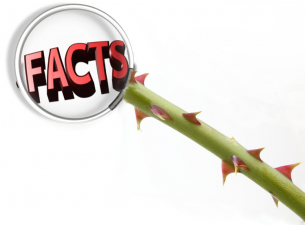 Evidence analysis is the proverbial thorn in the thumb for many history researchers. We’d love to gather blossoms from the rose garden and make beautiful bouquets from them. But those darn thorns have to be dealt with in the process.
Evidence analysis is the proverbial thorn in the thumb for many history researchers. We’d love to gather blossoms from the rose garden and make beautiful bouquets from them. But those darn thorns have to be dealt with in the process.
Our QuickTips on 9 August discussed the difference between the Evidence Analysis Map and the Genealogical Proof Standard: “EAM & GPS: Newsflash! Siblings, Not Twins.” To summarize that post:
- The Evidence Analysis Map that’s tucked into the front of Evidence Explained and the back of Genealogy Standards, focuses on the nitty gritty data-gathering we do every day. (You'll also find it discussed in detail in QuickLesson 17 (
- The Genealogical Proof Standard is a set of five criteria we use to measure whether or not a conclusion is realiable.
That posting has prompted a “but” from a thoughtful reader who asks about Criteria 3 of the GPS: "Correlation and analysis." Let's call that GPS3, for short.
“Why isn’t that the place where we consider the Evidence Analysis Map?” he asks.
Good question.
The Evidence Analysis Map is definitely relevant to GPS3. But the EAM is not something we can pigeonhole into that one spot, just because GPS3 actually includes the word “analysis.”
Analysis is both granular (the EAM level) and cumulative (the GPS level). And analysis is required by all five criteria of the GPS.
Criteria 1: Reasonably exhaustive research using the best sources possible.
With each of those sources, we evaluate what it is, how reliable it is, how it can be used, and whether a better source is needed for that information.
Criteria 2: Thorough identification of all sources.
With each piece of information we take from a source, we have to analyze the qualities of the source and identify the source well enough to make clear its strengths and weaknesses.
Critera 3: Correlation and analysis.
Again, this applies to a whole body of work. It’s not the granular analysis of one item. It’s the comprehensive comparison of everything we have and how the whole fits together.
Criteria 4: Resolution of any conflicting evidence.
Again, we are dealing with analyses of the whole body for contradictions that have to be resolved.
Criteria 5: A written explanation of our evidence and why it amounts to proof. In this process, our analyses have to be explained.
In sum: everything we do, as researchers requires analysis, but
- Analysis is both granular and comprehensive. We analyze each individual thing and we analyze how the whole fits together.
- The EAM is granular. We use it with every action we take in the research process and we apply it to each individual thing we use.
- The GPS is comprehensive. We use it to evaluate the body of evidence used to support a conclusion.
IMAGE CREDIT: Adaptation of "Rose Thorn Stock Photo," CanStockPhoto (https://www.canstockphoto.com/rose-thorn-20672202.html : downloaded 9 January 2019), image csp20672202 uploaded by rtbilder, 24 June 2014; used under license.
HOW TO CITE: Elizabeth Shown Mills, "Exactly When Do We Analyze Our Evidence," blog post, QuickTips: The Blog @ Evidence Explained (https://www.evidenceexplained.com/quicktips/exactly-when-do-we-analyze-our-evidence : posted 9 January 2019).